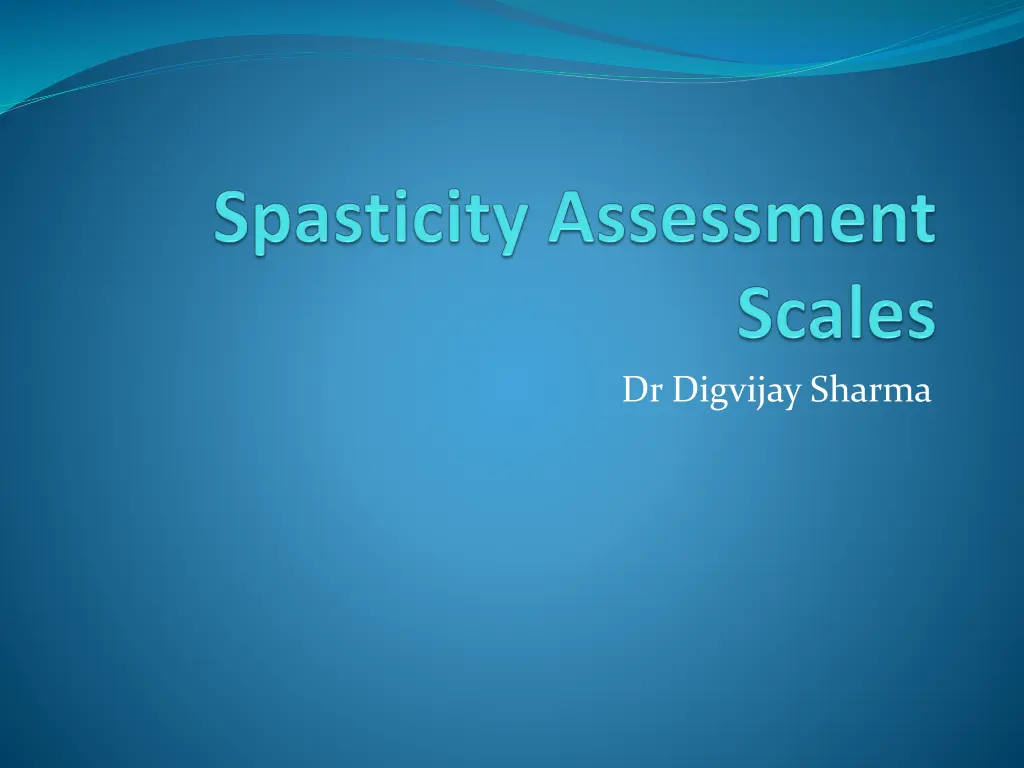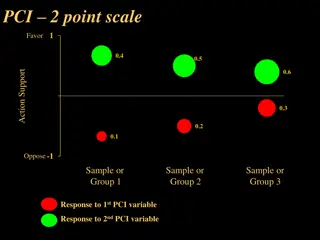
Understanding Spasticity: Causes, Symptoms, and Management
Spasticity is a common motor disorder characterized by muscle stiffness and reflex issues. Learn about its causes, symptoms, and epidemiology, and how it can be managed effectively. Explore the pathophysiology and treatment options for this condition.
Download Presentation

Please find below an Image/Link to download the presentation.
The content on the website is provided AS IS for your information and personal use only. It may not be sold, licensed, or shared on other websites without obtaining consent from the author. If you encounter any issues during the download, it is possible that the publisher has removed the file from their server.
You are allowed to download the files provided on this website for personal or commercial use, subject to the condition that they are used lawfully. All files are the property of their respective owners.
The content on the website is provided AS IS for your information and personal use only. It may not be sold, licensed, or shared on other websites without obtaining consent from the author.
E N D
Presentation Transcript
Spasticity Spasticity is one of the most common and potentially disabling and bothersome complications affecting conditions.1 individuals with Neurological Spasticity may be defined as a motor disorder characterized by a velocity- dependent exaggeration of stretch reflexes, resulting from abnormal intraspinal processing of primary afferent input.2 Clinically this implies increased muscle tone, enhanced tendon reflexes, extended reflex zones and clonus. 1-Kirshblum S. Treatment for spinal cord injury related spasticity. J Spinal Cord Med 1999; 22: 199 217 2-Young RR. Spasticity: a review. Neurology 1994; 44(Suppl 9): S12 S20.
Causes Spasticity occurs as a result of the damage of myelin and axonal fibres, and as a result of the deterioration of upper neuron stretch reflex. Three major mechanisms that are connected to upper motor neuron lesion play role in the development of spasticity. These mechanisms are the changes of afferent input coming to spinal motor neurons, the changes in reflex arcs that affect motor neurons excitability and the changes of motor neurons internal features(3). 3.Burke D, Wissel J, Donnan GA. Pathophysiology of spasticity in stroke. Neurology. 2013;80:S20 26.
Epidemology There are varied figures for prevalence of spasticity in different conditions This may be due to the presence of many patients with mild spasticity for whom little or no treatment is required for their condition. An early brain injury study in the UK estimates that 16% and 18% of first time stroke sufferers and patients following traumatic brain injury respectively require spasticity treatment
In a Swedish study, the observed prevalence of any spasticity one year after first ever stroke was 17% and of disabling spasticity was 4% An American study showed a prevalence of 35% among adults living in a developmental centre. Among all ages, the estimated annual incidence of ischemic and hemorrhagic stroke is 183 per 100,000 in the US
Pathophysiology The pathophysiology is obscure, findings on examination are inconsistent, and treatment is not always successful, hence spasticity is managed and not treated Understanding the physiology of normal movement may help the physician in the understanding of pathophysiology of spasticity
SYMPTOMS Spasticity can range from mild muscle stiffness to severe, painful and uncontrollable muscle spasms It is associated with both positive and negative components of upper motor neuron syndromes
Positive components It includes- muscle overactivity, flexor and extensor spasm, hyperreflexia, athetosis, spastic dystonia, clonus, extensor plantar response
Negative symptoms Common negative symptoms comprise, weakness/ paralysis, early hypotonia, fatigue loss of dexterity
Spasticity Measurement Methods Although spasticity is a well-known disorder, the measurement and evaluation processes are still problematic (4). Many methods for spasticity measurement have been developed; they can be separated into two groups as the clinical evaluation methods and quantitative evaluation methods. 4. Malhotra S, Pandyan AD, Day CR, Jones PW, Hermens H. Spasticity, an impairment that is poorly defined and poorly measured. Clin Rehabil. 2009;23:651 658.
Clinical evaluation The clinical evaluation of spasticity begins with the detailed history and physical examination.
physical examination In this phase, the existence and frequency of flexor or extensor spasms are investigated and recorded, the posture analysis is made.
quantitative evaluation The quantitative evaluation method of spasticity are significant both for the treatment plan and for the measurement of response to treatment. However, this method is quite difficult and it has a tendency to depend on the person making the measurement. Besides, the fact that spasticity may differ from day to day, and even within the same day, makes the measurement harder.
Spasticity measurement methods 1. Clinical scales 2. Biomechanical methods Pendulum test Isokineticdynamometers 3. Neurophysiological-Electrophysiological methods H response H / M ratio ratio Other reflex studies F Response, F / M
Spasticity measurement methods 4. Walking analysis methods Dynamic EMG Kinematic and kinetic registration 5. New methods Elastography Myotonometry
Clinical Scales A large number of clinical scales are used to evaluate spasticity and/or the related situations (5). Frequently used scales are - 5.Platz T, Eickhof C, Nuyens G, Vuadens P. Clinical scales for the assessment of spasticity, associated phenomena, and function:a systematic review of the literature. Disabil Rehabil. 2005;27:7 18.
frequently used scales in spasticity and related situations 1.Ashworth Scale 2.Modified Ashworth Scale 3.Penn Spasm Frequency Scale 4.Spasm Severity Scale 5.Hygiene Scale 6.Evaluation of deep tendon reflexes Scale 7.Clonus Score
frequently used scales 8.Plantar stimulation response Scale 9.Fugyl Meyer Scale 10.Disability Assessment Scale 11.Tone Assessment Scale 12.Tardieu/Modified Tardieu Scale 13.Barthel Index, Functional Independence Scale 14.Multiple Sclerosis Spasticity Scale, MSSS-88
The Ashworth and modified Ashworth scales The most frequently used clinical methods for estimation of spasticity are the Ashworth Scale (AS) and the ModifiedAshworth Scale (MAS)
Ashworth Scale (AS) Grade ModifiedAshworth Scale (MAS) No increase in tone 0 No increase in muscle tone Slight increase in tone giving a 1 Slight increase in muscle tone, manifested by a catch when the limb was moved in catch and release or by minimal resistance at he flexion or extension end range of motion when the affected part is moved in flexion or extension - 1+ (2) Slight increase in muscle tone, manifested by a catch, followed by minimal resistance through the remainder (less than half) of the ROM More marked increase in tone but 2 (3) More marked increase in muscle tone through limb easily flexed most of the ROM but the affected part is easily moved Considerable increase in tone- 3 (4) Considerable increase in muscle tone, passive passive movement difficult movement is difficult Limb rigid in flexion or extension 4 (5) Affected part rigid in flexion or extension
Advantages Of AS Scale The AS is simple, requires no instrumentation and is easy and quick to carry out, and has been used in a number of studies. Bohannon and Smith6found that many of patients demonstrated levels of spasticity towards the lower end of the scale and included an extra category (1+) to render the scale more discrete. At the same time, they modified the definitions slightly.
The interrater reliability of the two tests (AS & MAS) has been tested in several studies. In addition, four studies have evaluated the intra-rater reliability of MAS.
Authors (Year) Population Intra-rater reliability Inter-rater reliability Bohannon and Smith (1987)6 Cerebrovascular, Closed head injury, Multiple Sclerosis Agree 86.7%, never disagreed more than one grade t 0.85 (P<0.001) Sloan et al (1992)7 Hemiplegia, injury Head Mean r 0.45 0.74, lowest for knee flexion. P<0.01, but not for the Knee Nuyens (1994)8 et al Thirty multiple sclerosis t reliable for muscles of the ankle than knee and hip, lowest for hip adductors & internal Rotators 0.24 0.86 (P=0.143 0.0001), more Haas et al (1996)9 Thirty spinal cord injury Agree 40.0% 72.4%, k 0.20 0.62. Poorest for plantar flexors. Highest agreement for score 0. Overall reliability only Fair Allison (1996)10 et al Thirty traumatic brain injury Agree 48 53% r 0.55 and 0.74, k 0.29 and 0.69, t-0.48 and 0.67 Agree 55%. r 0.73, k 0.40, p 0.65. Reliability for plantar flexors less optimal Gregson (1999)11 et al Acute stroke Agree 32%. Kw 0.83 Agree 32%. Kw 0.83 Gregson (2000)11 et al Acute stroke Elbow: Agree 62 72%, k 0.39 0.53 Wrist: Agree 59 71%, k 0.35 0.48, Elbow: Agree 59 78%, k 0.34 0.67, Wrist: Agree 66 71%, k 0.43 0.51 Elbow: Agree 62 72%, k 0.39 0.53, Wrist: Agree 59 71%, k 0.35 0.48, Elbow: Agree 59 78%, k 0.34 0.67, Wrist: Agree 66 71%, k 0.43 0.51, 6- Bohannon RW, etal. Interrater reliability of a modified Ashworth Scale of muscle spasticity. Phys Ther 1987; 67: 206 207. 7-Sloan RL, etal. Inter-rater reliability of the modified Ashworth scale for spasticity in hemplegic patients. Int J Rehabil Res 1992; 15:158 161. 8- Nuyens G et al. Inter-rater reliability of the Ashworth scale in multiple sclerosis. Clin Rehabil 1994; 8: 286 292. 9- Haas BM, etal. The inter rater reliability of the original and of the modified Ashworth scale for the assessment of spasticity in patients with spinal cord injury. Spinal Cord 1996; 34: 560 564. 10- Allison SC, etal. Reliability of the modified Ashworth scale in the assessment of plantarflexor muscle spasticity in patients with traumatic brain injury. Int J Rehabil Res 1996; 19: 67 78.
Gregson et al found the intra- as well as the interrater reliability for the MAS is good to very good for elbow, wrist and knee, but less satisfactory over the ankle The MAS will need to be treated as a nominal level measure of resistance to passive movement until the ambiguity between the 1 and +1 grades is resolved
Spasm Frequency Scale The original Penn spasm frequency scale12 was created to follow the effect of intrathecal baclofen in 20 patients with spasticity caused by multiple sclerosis and SCL . For this purpose, the scale was sufficiently sensitive, whereas it may be less optimal for other purposes; in particular, when the treatment effect influences score 3 and 4 12- Penn RD et al. Intrathecal baclofen for severe spinal spasticity. N Engl J Med 1989; 320: 1517 1521.
Various clinical examination scores, including the Penn spasm frequency scale, AS, standard scales of tendon taps, clonus, and plantar stimulation correlated poorly with each other, suggesting that they each assess different aspects of the spastic syndrome. Until now no any reliability studies available.
Penn Spasm Frequency Scale Score Spasm frequency score No spasms 0 No spasms Mild spasms at stimulation 1 One or fewer spasms per day Irregular strong spasms less than 1 time/h 2 Between 1 and 5 spasms per day Spasms more often than 1 time/h 3 Five to less than 10 spasms per day Spasms more than 10 times/h 4 Ten or more spasms per day, or continuous contraction
Tardieu Scale and Modified Tardieu Scale (MTS) One of the scales that evaluate spasticity with the passive motion is Tardieu Scale. Passive stretch is performed in the same, lower or higher speed of the fall of extremity segments with gravity. Modified Tardieu Scale (MTS) has been developed by adding to Tardieu Scale the extremities evaluation positions and the angle of spasticity (13). 13. Haugh AB, Pandyan AD, Johnson GR. A systematic review of the Tardieu Scale for the measurement of spasticity. Disabil Rehabil. 2006;28:899 907.
Modified Tardieu Scale Muscle reaction quality (X) 0- No resistance during passive motion 1- Minimal resistance during passive motion, no sense of catching at a certain angle Feeling of catching at a certain angle (cuts passive movement, relaxes afterwards) Weakening clonus (less than 10 seconds when stretching is continued and occurs at a certain angle) 2- 3- 4- Strong clonus (longer than 10 seconds when stretching is continued and emerging at a certain angle) 5- The joint can not be moved Stretching Speed: V1: As slow as possible, slower than the natural drop of the extremity segment due to gravity effect V2: Extremity segment at the natural deceleration rate due to gravity effect As fast as possible, faster than the natural fall of the extremity segment due to gravity V3:
Fugl Meyer Scale (FMS) Fugl Meyer Scale (FMS) is a scale in which spasticity is evaluated with many parameters like the sense of touch and pain, and the joint position sense of hand, wrist, and body posture
Fugl Meyer Scale (FMS Shoulder, elbow, forearm and lower extremity movement I- Muscle stretching reflexes can be obtained II- Voluntary movement is done with dynamic flexor / elevator synergy III- Voluntary movement is made by comparing dynamic flexor / elevator synergies IV- There is little or no need for synergies to make voluntary movements V- Normal muscle stretching reflexes Wrist function - stability, flexion, extension, circumduction Hand function General flexion, general extension, five different grips Coordination and speed-tremor, dysmetry and speed assessment Finger-nose test, heel-calf test Balance Non-supported seating Parachute reaction-unaffected and on the affected side Standing-assisted and unsupported Standing on the affected side and on the unaffected side Sense-touch, sense of position Passive joint movement, joint pain
Biomechanical Evaluation Biomechanical measurements give a controlled warning to the patient and measure mechanical response to motion using, torque, position sensors and electromyography (EMG).
Isokinetic dynamometers Isokinetic dynamometers have frequently been used for assessment and evaluation of spasticity. Advantage is that they make a standardization of the applied stretch velocity and amplitude possible, and thereby are able to quantify the velocity-dependent resistance in the muscle to passive movement.
The reliability and validity of isokinetic dynamometers (Kin-Coms, Cybex) has been examined in several studies,40 42 from which it can be concluded that the resistive force values are highly reproducible for low as well as high-angle velocities, and in able bodied as well as in individuals with cerebral palsy and Spinal cord lesions.
Authors (Year) Population Intra-rater reliability Inter-rater reliability Boiteau et al.14 CP (age 2 7 years), 3 hemiplegia Kin-Coms: ICC 0.84 at LV ICC 0.84 at HV Hand-held: ICC 0.79 at LV ICC 0.90 at HV Kin-Coms: Resistance 11.8 12.8% Hand-held: Resistance 13.2 13.9%) Lamontagne etal.15 Spinal Cord Lesions Kin-Coms: ICC 0.83 at LV ICC 0.75 at HV Hand-held: ICC 0.93 at LV ICC 0.84 at HV Kin-Coms: Resistance 3.14 6.43% Velocity 0.47 7.84% Hand-held: Resistance 7.98 16.11% Velocity 12.74 40.43% Kakebeeke, etal.16 Twenty SCL (C5 T6) (ASIA A/B) Minimum 4 months post injury ICC, Extensors: Peak/sum 0.72 0.84 Flexors: Peak/sum 0.22 0.89 t 0.24 0.86 (P=0.143 0.0001), more reliable for muscles of the ankle than knee and hip, lowest for hip adductors & internal Rotators 14- Boiteau M, Malouin F, Richards CL. Use of hand-held dynamometer and a Kin-Com dynamometer for evaluating spastic hypertonia in children: a reliability study. Phys Ther 1995; 75: 796 802. 15- Lamontagne A, Malouin F, Richards CL, Dumas F. Evaluation of reflex- and nonreflex-induced muscle resistance to stretch in adults with spinal cord injury using hand-held an isokinetic dynamometer. Phys Ther 1998; 78: 964 975. 16-Kakebeeke TH, Lechner H, Baumberger M, Denoth J, Michel D, Knecht H. The importance of posture on the isokinetic assesment of spasticity. Spinal Cord 2002; 40: 236 243.
Pendulum test The pendulum test was introduced by Wartenberg in 1951.17 In its most simple form, the patient is seated or lying with the lower leg hanging over the end of a couch. The examiner then extends the leg to the horizontal position, while the patient is told to relax. The leg is then released and allowed to swing freely under the action of gravity. With the use of electrogoniometers, the swing of the leg about the knee joint may be evaluated. 17- Wartenberg R. Pendulousness of the legs as a diagnostic test. Neurology 1951; 1: 18 24.
In individuals with spasticity, a reduction of the swing is generally present. The advantage of the pendulum test is its simplicity, and the more refined quantification of the severity of spasticity that is obtained compared to the AS. However, it also has several drawbacks. It depends crucially on how the person is seated and the ability of the person to relax fully.
Furthermore, it may only be used to evaluate spasticity in the knee muscles and it seems not to give any useful information in severe spasticity. Finally, it is not possible with the test to dissociate increased resistance in the muscle due to viscoelastic changes from the velocity-dependent resistance due to spasticity. Probably because of these drawbacks, the test has not obtained any wider use.
Electrophysiological methods It has been considered in a number of studies whether measurement of the evoked electrical activity from the muscles EMG may be used to evaluate spasticity either alone or in combination with biomechanical measurements.18 This approach seems logical given that the mechanical response of the muscle to some extent must be proportional to the electrical signal. 18- Sinkjaer T. Muscle, reflex and central components in the control of the ankle joint in healthy and spastic man. Acta Neurol Scand Suppl 1997; 28.
Limitations There are several problems in such studies. The size of the responses measured in the EMG depends heavily on such factors as the placement of the electrodes, skin resistance, subcutaneous fat, muscle atrophy, etc.19,20 It is therefore not possible to compare the absolute amplitude of the responses between or even within subjects from session to session. 19- Sko ld C, Harms-Ringdahl K, Hultling C, Levi R, Seiger A. Simultaneous Ashworth measurements and electromyographic recordings in tetraplegic patients. Arch Phys Med Rehabil 1998; 79: 959 965. 20- Zupan B, Stokic DS, Bohanec M, Priebe MM, Sherwood AM. Relating clinical and neurophysiological assessment of spasticity by machine learning. Int J Med Inform 1998; 49: 243 251.
Gait Analysis Methods Spasticity is one of the problems that reducing the quality of life of patients with MS. All components of motor impairment (motor loss, spasticity, co- contraction, sensory loss, contracture) should be determined in order to evaluate the spastic lower extremities. Optoelectronic motion analysis systems, force platforms, multi-channel EMG devices are used for quantitative gait analysis (21). 21. M h r H, Akku S. Normal ve Patolojik Y r me. In: O uz H, Dursun E, Dursun N, editors. T bbi Rehabilitasyon. Istanbul: Nobel T p Kitabevleri; 2004. pp. 265 279.
kinetic and kinematic measurements Today, kinetic and kinematic measurements have become more practical and useful, thanks to portable and wearable devices. Owing to the sensors, static and dynamic acceleration can be measured, with the devices capable of perceiving the slope and posture analysis can be made easier. At this point, the response to the treatment can be easily monitored and the risks of falling have become able to be reduced.
Elastography Elastography is a new way of visualizing the flexibility of biological tissues and is often used to detect malignant lesions in the tissues, such as thyroid, breast tissues, etc (22). Lately it has also been used to measure the flexibility of muscles, tendons and nerves. It is also known as compression elastography, sonoelastography, or real-time ultrasound elastography (RTHE) (23). 22. Illomei G. Muscle elastography in multiple sclerosis spasticity. Neurodegener Dis Manag. 2016;6:13 16. 23. Drakonaki EE, Allen GM, Wilson DJ. Ultrasound elastography for musculoskeletal applications. Br. J. Radiol. 2012;85:1435 1445.
Myotonometry Myotonometry is a new technique which allows objective assessment of muscle spasticity by quantifying tissue displacement response to a standard measuring perpendicular compression force. Besides neurological disorders, it has also been used to investigate changes in muscle tissues of patients such as scoliosis and dull shoulder (21, 22) 21. Oliva-Pascual-Vaca A, Heredia-Rizo AM, Barbosa-Romero A, Oliva-Pascual-Vaca J, Rodr guez-Blanco C, Tejero-Garc a S. Assessment of paraspinal muscle hardness in subjects with a mild single scoliosis curve:a preliminary myotonometer study. J Manipulative Physiol Ther. 2014;37:326 333. 22. Hung CJ, Hsieh CL, Yang PL, Lin JJ. Relationships between posterior shoulder muscle stiffness and rotation in patients with stiff shoulder. J Rehabil Med. 2010;42:216 220.
CONCLUSION quantitative assessment of spasticity is difficult. Evaluation of spasticity should be based on clinical assessment with additional repeated biomechanical and electrophysiological measurements obtained during active and functional movements as complementary techniques. In addition, the patient should also be allowed to self-assess his or her symptoms. 23.Belgin Petek Balci,Noro Psikiyatr Ars.s 2018; 55(Suppl 1): S49 S53






















